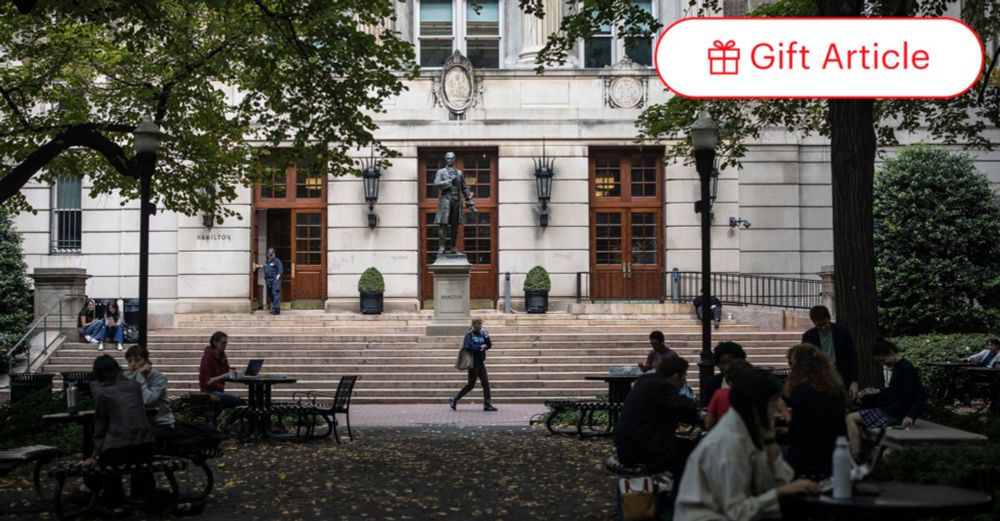
Abstract. We consider FB-PRF, one of the key derivation functions defined in NIST SP 800-108 constructed from a pseudorandom function in a feedback mode. The standard allows some flexibility in the specification, and we show that one specific instance of FB-PRF allows an efficient distinguishing attack.
A Note on Feedback-PRF Mode of KDF from NIST SP 800-108 (Ritam Bhaumik, Avijit Dutta, Tetsu Iwata, Ashwin Jha, Kazuhiko Minematsu, Mridul Nandi, Yu Sasaki, Meltem Sönmez Turan, Stefano Tessaro) ia.cr/2025/1586
05.09.2025 11:32 — 👍 0 🔁 1 💬 0 📌 0

Abstract. This paper studies the security of key derivation functions (KDFs), a central class of cryptographic algorithms used to derive multiple independent-looking keys (each associated with a particular context) from a single secret. The main security requirement is that these keys are pseudorandom (i.e., the KDF is a pseudorandom function). This paper initiates the study of an additional security property, called key control (KC) security, first informally put forward in a recent update to NIST Special Publication (SP) 800-108 standard for KDFs. Informally speaking, KC security demands that, given a known key, it is hard for an adversary to find a context that forces the KDF-derived key for that context to have a property that is specified a-priori and is hard to satisfy (e.g., that the derived key consists mostly of 0s, or that it is a weak key for a cryptographic algorithm using it). We provide a rigorous security definition for KC security, and then move on to the analysis of the KDF constructions specified in NIST SP 800-108. We show, via security proofs in the random oracle model, that the proposed constructions based on XOFs or hash functions can accommodate for reasonable security margins (i.e., 128-bit security) when instantiated from KMAC and HMAC. We also show, via attacks, that all proposed block-cipher based modes of operation (while implementing mitigation techniques to prevent KC security attacks affecting earlier version of the standard) only achieve at best 72-bit KC security for 128-bit blocks, as with AES.
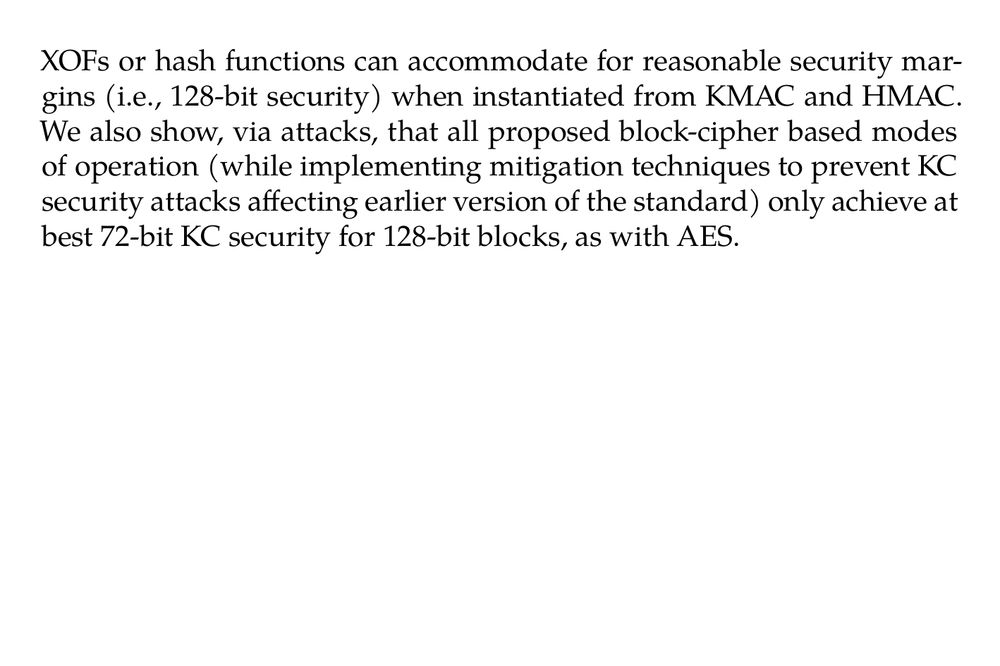
Image showing part 2 of abstract.
Cryptographic Treatment of Key Control Security – In Light of NIST SP 800-108 (Ritam Bhaumik, Avijit Dutta, Akiko Inoue, Tetsu Iwata, Ashwin Jha, Kazuhiko Minematsu, Mridul Nandi, Yu Sasaki, Meltem Sönmez Turan, Stefano Tessaro) ia.cr/2025/1123
16.06.2025 21:21 — 👍 4 🔁 3 💬 0 📌 0
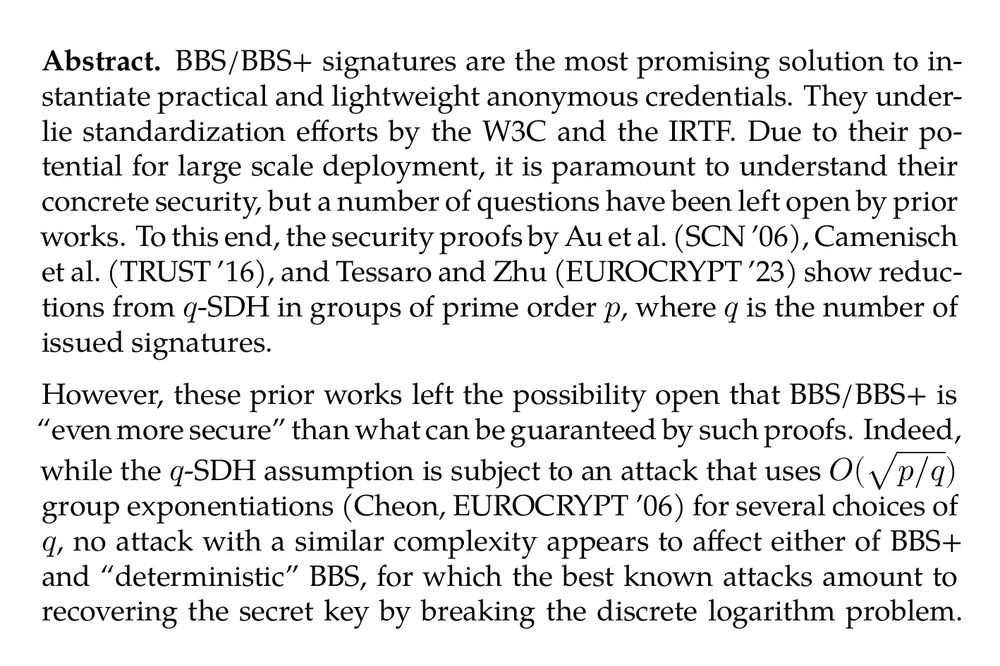
Abstract. BBS/BBS+ signatures are the most promising solution to instantiate practical and lightweight anonymous credentials. They underlie standardization efforts by the W3C and the IRTF. Due to their potential for large scale deployment, it is paramount to understand their concrete security, but a number of questions have been left open by prior works. To this end, the security proofs by Au et al. (SCN ’06), Camenisch et al. (TRUST ’16), and Tessaro and Zhu (EUROCRYPT ’23) show reductions from q-SDH in groups of prime order p, where q is the number of issued signatures.
However, these prior works left the possibility open that BBS/BBS+ is “even more secure” than what can be guaranteed by such proofs. Indeed, while the q-SDH assumption is subject to an attack that uses $O(\sqrt{p/q})$ group exponentiations (Cheon, EUROCRYPT ’06) for several choices of q, no attack with a similar complexity appears to affect either of BBS+ and “deterministic” BBS, for which the best known attacks amount to recovering the secret key by breaking the discrete logarithm problem. The assumption that this attack is best possible also seemingly justifies the choice of parameters in practice.
Our result shows that this expectation is not true. We show new attacks against BBS+ and deterministic BBS which, after seeing q signatures, allow us to recover the secret key with the same complexity as solving the Θ(q)-Discrete Logarithm problem, which in turn is proportional to $O(\sqrt{p/q})$ for many choices of q. Further, we also extend the attack to a reduction showing that the security of BBS+ and deterministic BBS implies the Θ(q)-SDH assumption.

Image showing part 2 of abstract.
On the Concrete Security of BBS/BBS+ Signatures (Rutchathon Chairattana-Apirom, Stefano Tessaro) ia.cr/2025/1093
12.06.2025 12:26 — 👍 1 🔁 2 💬 0 📌 0

Abstract. FROST and its variants are state-of-the-art protocols for threshold Schnorr signatures that are used in real-world applications. While static security of these protocols has been shown by several works, the security of these protocols under adaptive corruptions—where an adversary can choose which parties to corrupt at any time based on information it learns during protocol executions—has remained a notorious open problem that has received renewed attention due to recent standardization efforts for threshold schemes.
We show adaptive security (without erasures) of FROST and several variants under different corruption thresholds and computational assumptions. Let n be the total number of parties, t+1 the signing threshold, and t_c an upper bound on the number of corrupted parties.
1. We prove adaptive security when t_c = t/2 in the random oracle model (ROM) based on the algebraic one-more discrete logarithm assumption (AOMDL)—the same conditions under which FROST is proven statically secure.
2. We introduce the low-dimensional vector representation (LDVR) problem, parameterized by t_c, t, and n, and prove adaptive security in the algebraic group model (AGM) and ROM based on the AOMDL assumption and the hardness of the LDVR problem for the corresponding parameters. In some regimes (including some t_c >t/2) we show the LDVR problem is unconditionally hard, while in other regimes (in particular, when t_c = t) we show that hardness of the LDVR problem is necessary for adaptive security to hold. In fact, we show that hardness of the LDVR problem is necessary for proving adaptive security of a broad class of threshold Schnorr signatures.
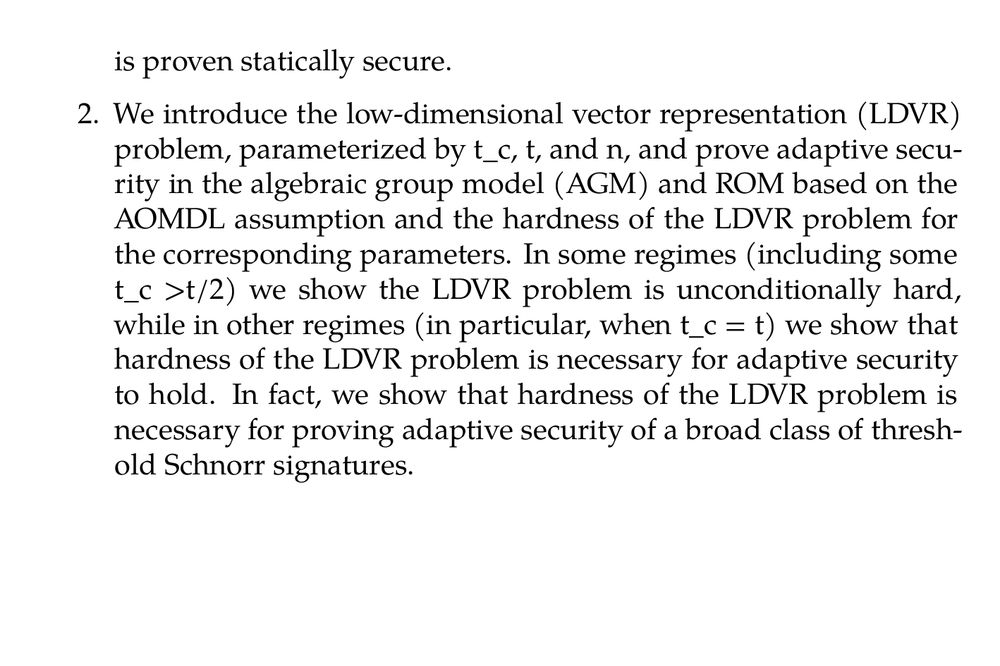
Image showing part 2 of abstract.
On the Adaptive Security of FROST (Elizabeth Crites, Jonathan Katz, Chelsea Komlo, Stefano Tessaro, Chenzhi Zhu) ia.cr/2025/1061
09.06.2025 03:28 — 👍 3 🔁 1 💬 0 📌 0
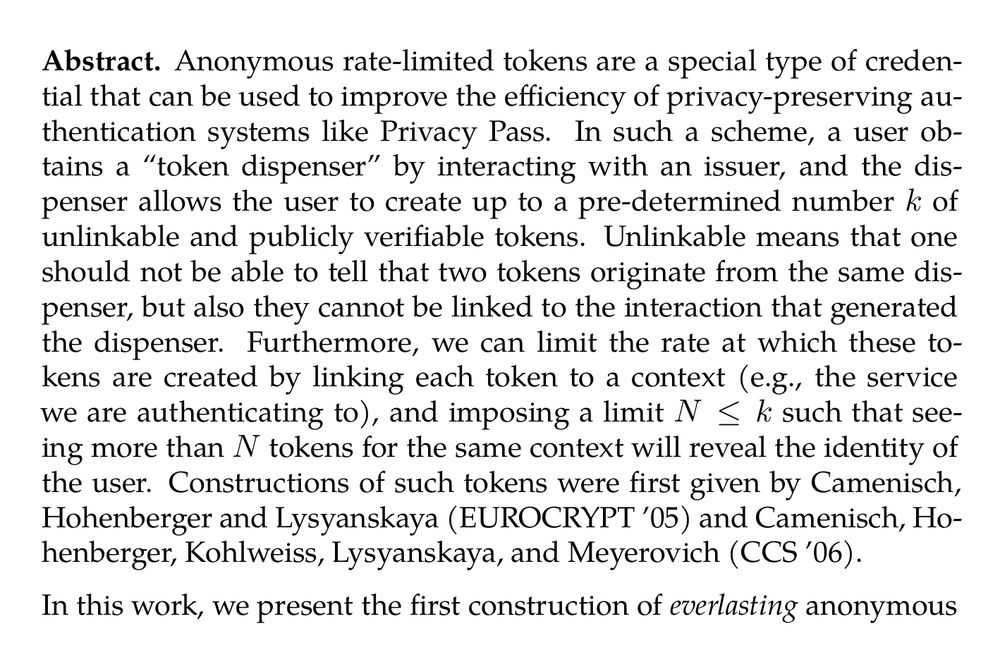
Abstract. Anonymous rate-limited tokens are a special type of credential that can be used to improve the efficiency of privacy-preserving authentication systems like Privacy Pass. In such a scheme, a user obtains a “token dispenser” by interacting with an issuer, and the dispenser allows the user to create up to a pre-determined number k of unlinkable and publicly verifiable tokens. Unlinkable means that one should not be able to tell that two tokens originate from the same dispenser, but also they cannot be linked to the interaction that generated the dispenser. Furthermore, we can limit the rate at which these tokens are created by linking each token to a context (e.g., the service we are authenticating to), and imposing a limit N ≤ k such that seeing more than N tokens for the same context will reveal the identity of the user. Constructions of such tokens were first given by Camenisch, Hohenberger and Lysyanskaya (EUROCRYPT ’05) and Camenisch, Hohenberger, Kohlweiss, Lysyanskaya, and Meyerovich (CCS ’06).
In this work, we present the first construction of anonymous rate-limited tokens, for which unlinkability holds against computationally unbounded adversaries, whereas other security properties (e.g., unforgeability) remain computational. Our construction relies on pairings. While several parameters in our construction unavoidably grow with k, the key challenge we resolve is ensuring that the complexity of dispensing a token is independent of the parameter k.
We are motivated here by the goal of providing solutions that are robust to potential future quantum attacks against the anonymity of previously stored tokens. A construction based on post-quantum secure assumptions (e.g., based on lattices) would be rather inefficient—instead, we take a pragmatic approach dispensing with post-quantum security for properties not related to privacy.
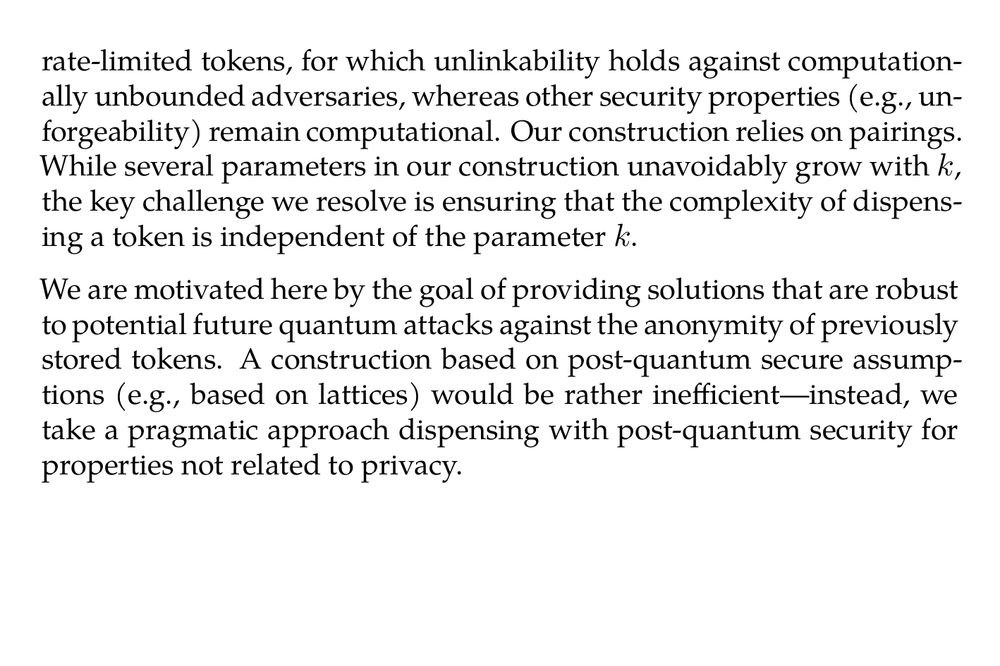
Image showing part 2 of abstract.
Everlasting Anonymous Rate-Limited Tokens (Rutchathon Chairattana-Apirom, Nico Döttling, Anna Lysyanskaya, Stefano Tessaro) ia.cr/2025/1030
03.06.2025 20:16 — 👍 2 🔁 1 💬 0 📌 0
I feel G1 arithmetic speed up would make it much more interesting. But arguably, this is subjective, and depends on what you are working on. Cool either way.
25.04.2025 19:49 — 👍 3 🔁 0 💬 0 📌 0
I am worried about my reputation …
11.04.2025 22:56 — 👍 2 🔁 0 💬 0 📌 0
Knowing you, 3:20/km 5 x 800m on your first try.
11.04.2025 06:12 — 👍 1 🔁 0 💬 1 📌 0
Intervals (mostly) is not cardio 🤔
10.04.2025 22:48 — 👍 0 🔁 0 💬 1 📌 0
Congratulations!
05.04.2025 02:52 — 👍 2 🔁 0 💬 0 📌 0
The context was that this would maintain the rotation. Of course without that, Europe works just fine
29.03.2025 19:10 — 👍 0 🔁 0 💬 0 📌 0
Also, I think Mexico City would be an amazing location :-)
29.03.2025 17:19 — 👍 2 🔁 0 💬 0 📌 0
Of course. All I am saying is that someone needs to do it and submit a proposal. One word of caution is that South America is very easy for Europeans/Americans, but for others who need a visa could be very painful.
29.03.2025 17:14 — 👍 1 🔁 0 💬 2 📌 0
The obvious barrier is that you need to find a place with local organizers wanting to do it. For example, it wouldn't be easy for someone in the US to organize it in Mexico. So Canada becomes the obvious choice, with several visa issues even worse than the US.
29.03.2025 17:02 — 👍 0 🔁 0 💬 1 📌 0
But in all fairness, this just happened. I did not attend RWC due to a temporary effort to reduce travel costs. The point is that RWC is rotating exactly for this reason.
29.03.2025 16:41 — 👍 0 🔁 0 💬 1 📌 0
To be clear, I am not involved … (nobody at UW is)
29.03.2025 14:41 — 👍 5 🔁 0 💬 0 📌 0
Oh … sorry! But the PNW can be very beautiful in the rain, too. Just need the occasional escape…
24.03.2025 00:27 — 👍 1 🔁 0 💬 0 📌 0

Successful escape from PNW weather - Spring Break edition
23.03.2025 20:38 — 👍 11 🔁 0 💬 1 📌 0
New paper!
21.03.2025 02:32 — 👍 4 🔁 1 💬 0 📌 0
We have extended the submission deadline for the International Workshop on Foundations and Applications of Privacy-Enhancing Cryptography (PrivCrypt) by two weeks to April 4, 2025, AoE. Please help spread the word and consider submitting your work to join us in Munich in Summer 😎
20.03.2025 08:12 — 👍 3 🔁 5 💬 0 📌 0
Serious question (asking for a friend ...): which countries are currently not cutting funds for education & research?
17.03.2025 15:51 — 👍 0 🔁 0 💬 1 📌 0
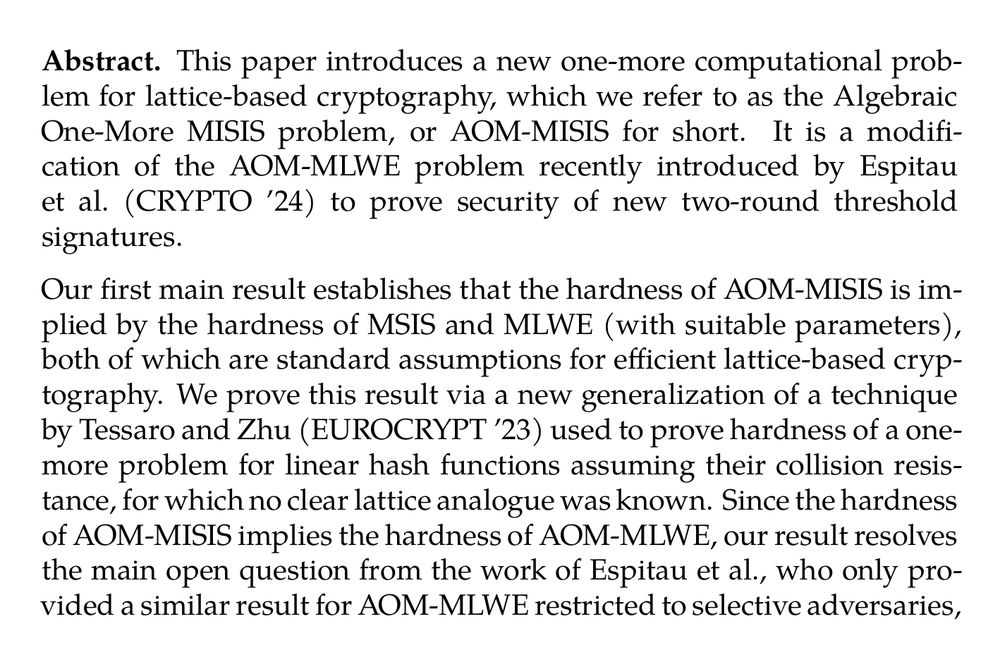
Abstract. This paper introduces a new one-more computational problem for lattice-based cryptography, which we refer to as the Algebraic One-More MISIS problem, or AOM-MISIS for short. It is a modification of the AOM-MLWE problem recently introduced by Espitau et al. (CRYPTO ’24) to prove security of new two-round threshold signatures.
Our first main result establishes that the hardness of AOM-MISIS is implied by the hardness of MSIS and MLWE (with suitable parameters), both of which are standard assumptions for efficient lattice-based cryptography. We prove this result via a new generalization of a technique by Tessaro and Zhu (EUROCRYPT ’23) used to prove hardness of a one-more problem for linear hash functions assuming their collision resistance, for which no clear lattice analogue was known. Since the hardness of AOM-MISIS implies the hardness of AOM-MLWE, our result resolves the main open question from the work of Espitau et al., who only provided a similar result for AOM-MLWE restricted to selective adversaries, a class which does not cover the use for threshold signatures.
Furthermore, we show that our novel formulation of AOM-MISIS offers a better interface to develop tighter security bounds for state-of-the-art two-round threshold signatures. We exemplify this by providing new proofs of security, assuming the hardness of MLWE and MSIS, for two threshold signatures, the one proposed in the same work by Espitau et al., as well as a recent construction by Chairattana-Apirom et al. (ASIACRYPT 2024). For the former scheme, we also show that it satisfies the strongest security notion (TS-UF-4) in the security hierarchy of Bellare et al. (CRYPTO ’22), as a result of independent interest.
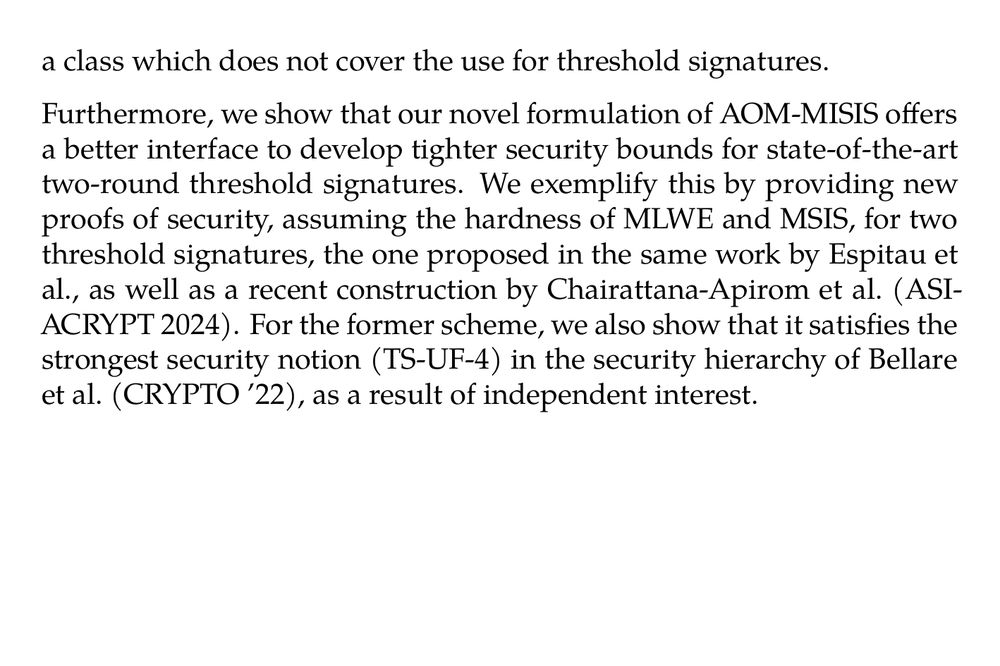
Image showing part 2 of abstract.
The Algebraic One-More MISIS Problem and Applications to Threshold Signatures (Chenzhi Zhu, Stefano Tessaro) ia.cr/2025/436
08.03.2025 01:37 — 👍 2 🔁 1 💬 0 📌 0
New paper: Simulating Time With Square-Root Space
people.csail.mit.edu/rrw/time-vs-...
It's still hard for me to believe it myself, but I seem to have shown that TIME[t] is contained in SPACE[sqrt{t log t}].
To appear in STOC. Comments are very welcome!
21.02.2025 22:19 — 👍 265 🔁 74 💬 17 📌 14
NSF is getting back to business due to a court order.
Order: nsf-gov-resources.ns...
Details: new.nsf.gov/executiv...
02.02.2025 21:31 — 👍 9 🔁 4 💬 0 📌 0
Of course, this is not good. But I’d be careful to generalize. Denmark or Switzerland are not representative of European academia either, which is not really on an upward trajectory either. I often find the US to only precede by few years where Europe will be soon (education, healthcare, …)
02.02.2025 18:50 — 👍 1 🔁 0 💬 0 📌 0
I feel you often put me in the position of correcting you even though I agree with your general points 😀 Many US states are far more progressive than Europe, and we do pay our employees (also, better). The article you linked above refers to a small subset of folks who are paid directly by NSF.
02.02.2025 18:50 — 👍 1 🔁 0 💬 1 📌 0
YouTube video by VASAviation -
Audio of MID-AIR CRASH into Potomac River | Regional Jet and Black Hawk Helicopter
I found this video (www.youtube.com/watch?v=CiOy...) more informative than any news article this morning. Not an expert, but sadly this appears to be a significant failure in designing procedures meant to be fault-tolerant.
30.01.2025 15:50 — 👍 0 🔁 0 💬 0 📌 0
I wonder if we can attack more examples where (1) circuits are adaptively chosen by the adversary, and (2) security proof is in the ROM. It always felt like playing with fire (because ROM does not model potential circuit dependence on the hash function), and this work nicely confirms the concern.
27.01.2025 13:40 — 👍 21 🔁 7 💬 0 📌 0










